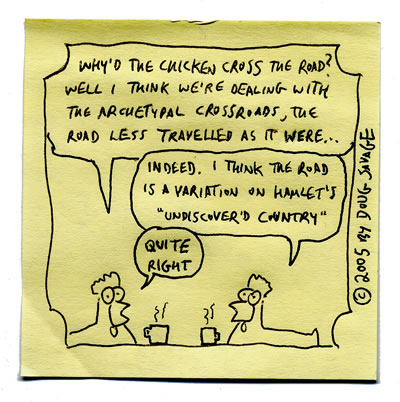Responding to Jonathan Allan and Clayton Chrusch
A footnote to “archetype spotting”: I think Frye refers to this procedure only once in his published writings––in his entry on “archetype” for the Harper Handbook to Literature. There he says,
Lycidas contains a reference to “that sanguine flower inscrib’d with woe” [l. 106], the hyacinth, thought to have obtained red markings resembling the Greek word ai (“alas”), when Hyacinthus was accidentally killed by Apollo. Milton could of course just as easily have left out this line: the fact that he included it emphasizes the conventionalizing element in the poem, but criticism that takes account of archetypes is not mere “spotting” of such an image. The critical question concerns the context: what does such an image mean by being where it is? (CW 18, 361).
(In his 1963 essay “Literary Criticism” Frye does speak of theme spotting. [CW 27, 128])
But in his notebooks Frye refers to the practice of “archetype spotting on several occasions:
Some fallacies in the archetypal approach beside the historical one: the counting one (if there are a lot of archetypes it’s a good poem), the spotting one, & others. (CW 23, 111)
I need more theory to connect these examples: otherwise it’s just archetype-spotting. (CW 5, 129)
The primary area of communication is conscious: it isn’t a case of deep calling to deep [Psalm 42:7]. If half the world uses an archetype & the other half doesn’t, it’s clear that it can mean something to that other half. The mystique of the unconscious has bedevilled myth critics. If you find fragments of a huge myth in primitive times, the process that put it all together is most likely to be in Shakespeare or Wagner or someone producing a waking dream for conscious minds [Plato, Sophist, 266c]. Such a writer would actualize what is potential in the archaic mythology. People resist this, because a poet’s consciousness may get self-conscious, turn coy or cute and go in for archetype-spotting. The poet (modern) is in the position of a medieval dog hitched to a mandrake root: it doesn’t matter so much if he goes mad, but the root he’s pulling is not just his own tail. (CW 5, 130)
The sense of unreality I feel about this book focused originally on the thinness of literary allusions: even things as deep in me as Shakespeare weren’t getting in. Then there was a sense of too much archetype-spotting, in contrast to real argument. That extended to too much kerygma spotting in 4. Finally I’m back to the Introduction, where I don’t even repeat my original confidence in the Bible as the only sacred book with a literary shape. Put that back in, you stupid bastard. [See WP, xviii, xx.] (CW 5, 369)
Many years ago young Woodberry [J.C. (Jack) Woodbury, a student at Toronto 1951–54], when a student of mine, spoke of the triviality of “archetype-spotting,” and I’ve always tried to recognize that. (CW 6, 564–5)
Every poem is “unique,” in the soft-headed phrase, and “archetype spotting” is a facile and futile procedure; but the traditions and conventions of poetry make a shape and a meaning. They move toward a future (emergence of primary concerns), and they expand into a wider present. (CW 6, 641)
The value of the book will be in this deductive expounding of the myth, not in spotting the archetypes around the compass. (CW 9, 263)
Here we see that Frye’s considers “archetype spotting” to be facile enterprise, and he warns against substituting it for argument. Having said this however, we need to remind ourselves that Frye did engage in a good bit of archetype spotting himself, especially when he was making notes on the texts he was reading. In Notebook 7, for example, he does engage in some rather extensive archetype spotting in Frobenius, Silberer, and Jung (CW 23, 8–15). The same is true of his Notes on Romance (in the weblog Library). Finally, the margins of the books in Frye’s personal library are filled with hundreds of notations about this or that archetype. A sample of these can be found in “Annotations in Frye’s Books,” also in the weblog Library. To speak about an archetype in a literary or any other work, you must of course first be able to spot it. Frye’s point is that if you do only this, then you’ve not made much of a contribution to critical understanding. It’s a procedure that can produce trivial observations, if they are not seen in some wider context of function, structure, and meaning.


Might there be a distinction to be made between literal motif and the thematic motif in a given text? The former would involve correspondence within the bounds of the given text (anaphora, for example), and latter would determine to what extent those motifs are subsumed into and point towards larger conventions.
The literal motif would be the more material symbol that inflects differently within the text and even across the genre. The thematic would align towards the governing archetypes and mythoi of the text. The degrees of discordance between the two (eventually leading to contrasting archetypes and ideologies) could account for the presence of types of irony within each literary mode, whereas more formal structures of condensation and displacement govern the presence of archetypes in the different modes. I may be veering off the cliff, here.
This is just a passing, somewhat convoluted thought, which I am sure Frye addresses in the Anatomy’s chapter on symbolic criticism and elsewhere. But since, in his linguistic categories in Words With Power, the literal motifs are what begin the transition from descriptive language to rhetoric, and ultimately through the ideological towards the poetic, it may be useful to first read motifs as they relate within the individual text. Otherwise, archetype spotting is just another method of the deterministic, allegorical reading symptomatic of Marxist/biographical/historical/etc. criticism.